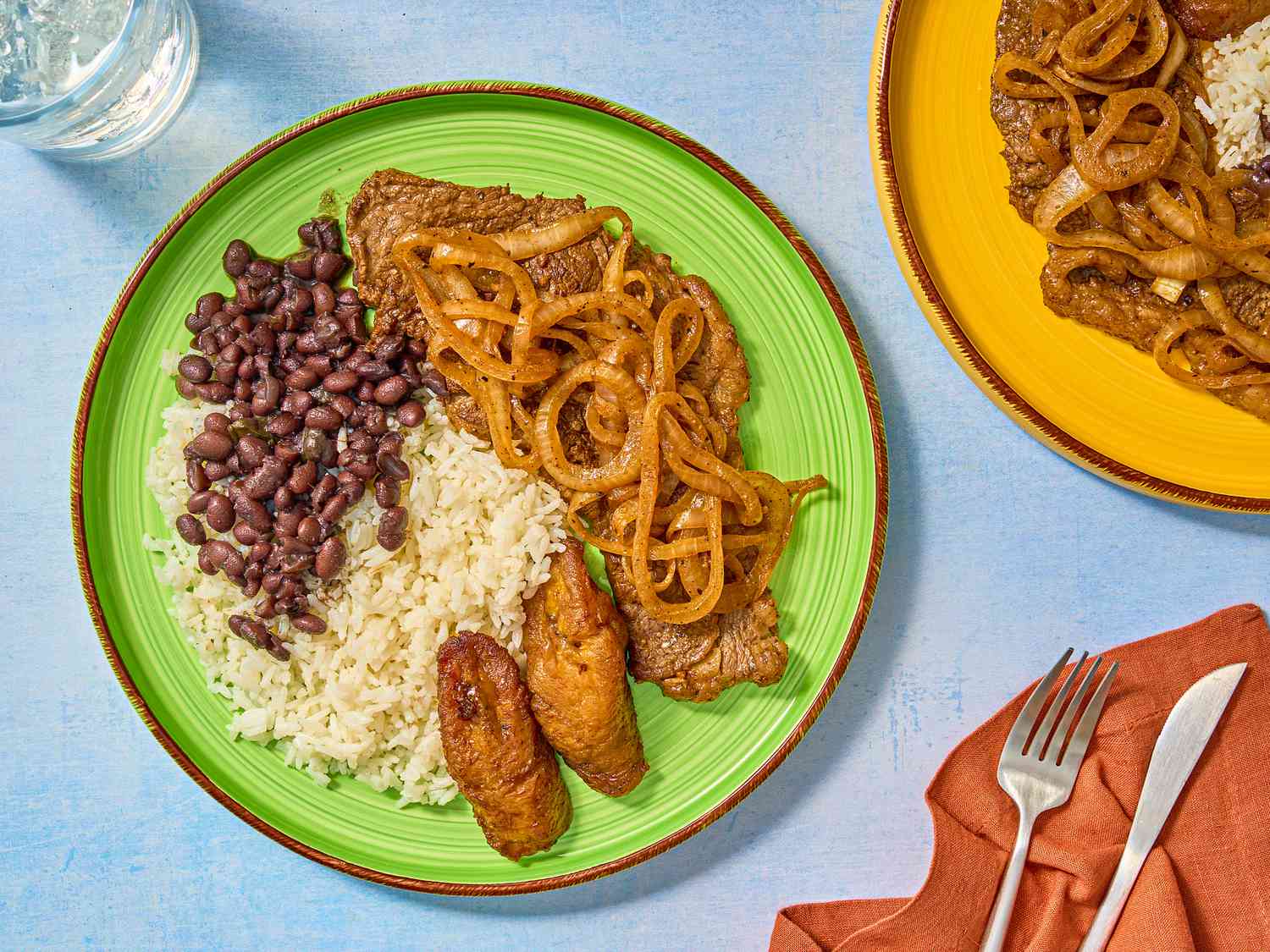
[ad_1]

Why It Works
- Pounding the steaks to a uniform thinness guarantees tender meat that cooks evenly and quickly.
- Salt and lime juice in the marinade flavor and tenderize the steaks.
- Rubbing garlic all over the steaks creates aromatic flavor.
- Searing the steaks in a hot skillet in batches ensures the steaks brown instead of steaming in their short cooking time.
Palomilla, Cuban steak and onions, holds a special place in my heart and belly. It was a staple weeknight dinner in my household throughout my childhood. My mom would serve the thin seared steaks with their signature browned onions to my dad and me often; always paired with a side of perfectly cooked white rice, black beans, and fried sweet plantains. When I’d hear the sound of the steaks sizzling with the smell of the lime-garlic marinade and accompanying onions, I knew dinner was going to be good that night.
Serious Eats / Two Bites
When I was older,I asked my mom to teach me her recipe, eager to capture her “secret” ingredients and techniques. To my surprise, she initially responded with a dismissive chuckle, insisting that there’s no real recipe for the dish, and that “every Cuban just knows how to make this.” Her response makes some sense; after all, the dish is little more than thin steaks quickly seared with onions and served hot right out of the skillet. But after watching my mom prepare it countless times in my life, I’ve realized there are a few key steps (whether she realized it or not) to preparing to get the most tender, juicy, well-seasoned bistec de palomilla possible. Read on to learn how.
Selecting the Right Cut of Beef
In Spanish, palomillo means moth or butterfly, referring to the way that the meat is sliced pencil-thin, or “butterflied” open to make two slim steaks of equal size. While I was accustomed to seeing these thinly sliced steaks at grocery stores around Miami, I realized I couldn’t tell you the exact cut of beef used and neither could my mother! When I pressed her for details about the cut of meat typically used in the recipe, she responded “I don’t know… palomilla steak.” A typical Cuban mom response!
After researching the dish more, and talking to local butchers in Miami, I learned that a tougher, inexpensive cut of meat like boneless top sirloin is typically used for bistec de palomilla. This makes sense: Fileting a tougher cut into thin steaks shortens the muscle fibers, making them more tender and easier to chew.
Serious Eats / Two Bites
While at my local Latin market in Miami I can easily find the recognizable thin butterflied steaks labeled intended for cooking palomilla at home, I realize for people living elsewhere, or without access to a Latin butcher, you might not find ready-made palomilla steaks. But most major supermarkets and butchers sell top sirloin—cut either into larger steaks or roasts—and with their help (or a sharp knife of your own), they can be turned into 1/4-inch thick filets, replicating the traditional palomilla style.
Whether you start with pre sliced steaks or you slice the steaks yourself, it’s important to still pound the steaks to make them even thinner and more tender. Sirloin steak can be used in a pinch, but they’ll be less tender than top sirloin and might require additional pounding to achieve the desired texture.
Why You Should Marinate Your Steaks
As Serious Eats discusses at length in its deep dive into marinating meat, most marinades rely on two key ingredients: salt and acid. Salt over time deeply seasons the meat and also ensures the steaks will retain more moisture once cooked. This is especially helpful for leaner, thinner cuts like the one used here. As for the acid, palomilla is traditionally marinated with lime juice. Not only does lime juice impart a bright, tangy flavor that’s signature for palomilla, but with just a little time time—between 30 minutes and four hours—it tenderizes the top sirloin steaks. Just be careful not to let the meat sit in the marinade too long, as the acid will eventually over-tenderize the beef, making it mushy.
The seasonings beyond that are simple, just garlic and black pepper. The flavor of ingredients like that won’t penetrate the meat—they’re just a a surface treatment—but with the steaks cut so thin, a surface treatment has a huge effect. Grating the garlic and rubbing it into the steaks ensures maximum flavor all over.
The Onions
The other signature element of palomilla is the onions, fried quickly in the skillet until browned and just growing tender. The key is to cook the onions over high heat to brown them in the pan’s remaining beef fat so that they develop a rich meaty flavor. A splash of lime juice and water produces just enough steam to help soften them without requiring a lengthy cooking time while infusing them with even more flavor.
Serious Eats / Two Bites
The type of onion used varies among households.Though you can certainly use yellow or Spanish onions for a sweeter alternative, I often opt for white onions, which I find produce a crisper finish and subtle pungency.
The result is an easy to prepare steak dinner that starts with just a handful of humble ingredients, but delivers a big, bright savory flavor.
[ad_2]